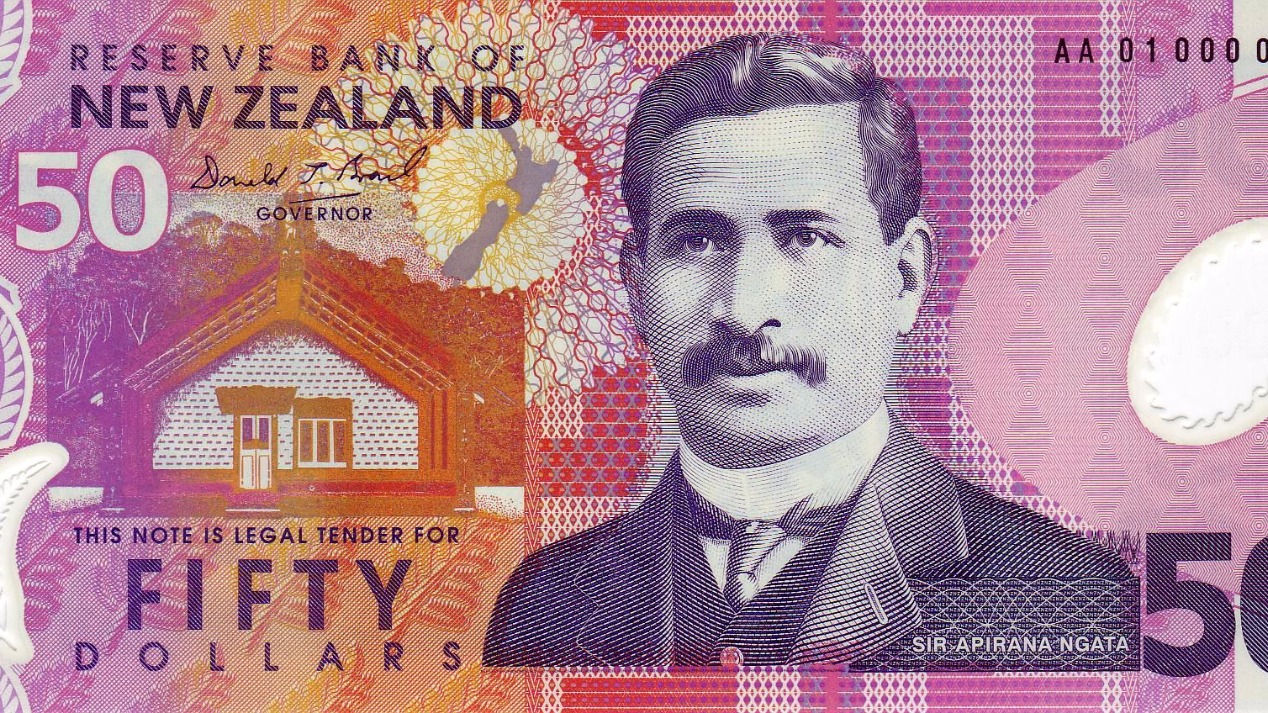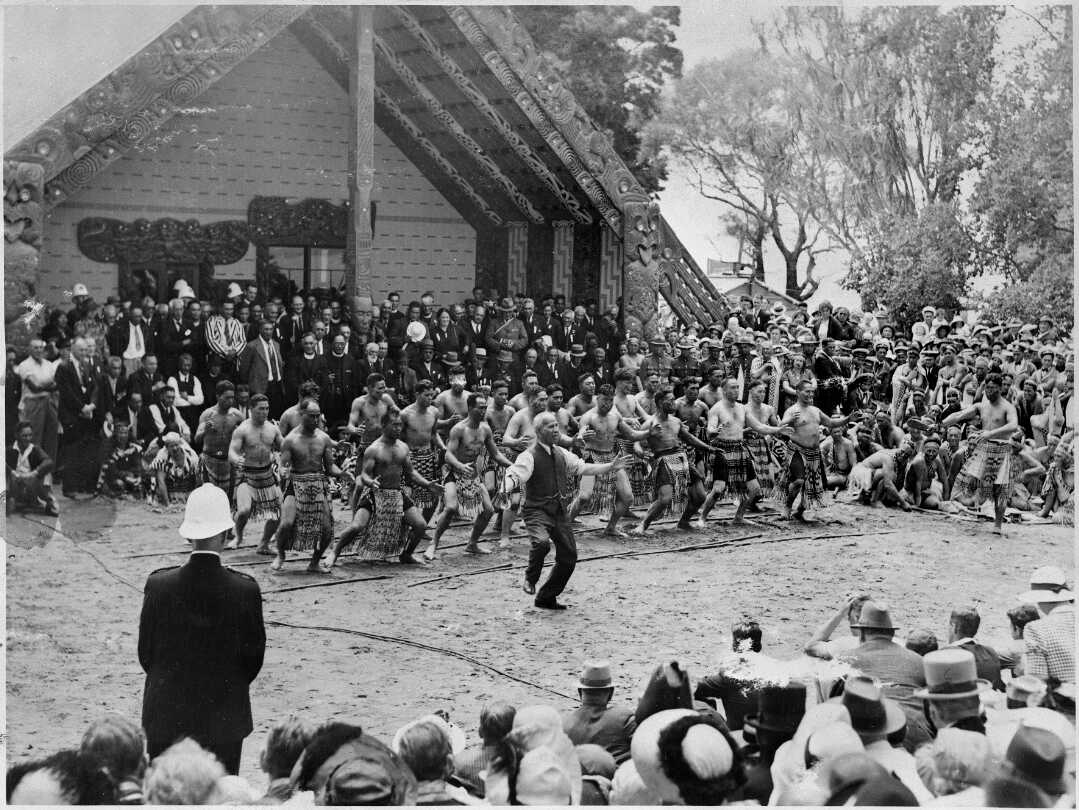Most people know him as a politician, but the face of our fifty-dollar note, Sir Āpirana Ngata, was passionate about so much more than meets the eye.
Our guest editor for Te Wiki o te Reo Māori, Nadine Millar (Ngāti Hine, Ngāpuhi), closes Māori Language Week with a call for us to hold on to our literary roots, as we forge our future.

On New Zealand’s fifty-dollar banknote, there’s a picture of a man most of us know. Sir Āpirana Ngata: handsome, fresh-faced and hopeful.
The photo must have been taken in his late twenties or early thirties during the early part of his career. He was a politician, a lawyer, an activist, a scholar. The first Māori to complete a degree, the first New Zealander to complete a double degree. He was a champion of Māori education and broadcasting, the father of the Māori Battalion, one of the most influential Ministers of Native (Māori) Affairs this country has ever seen. It’s impossible to pinpoint just one thing that defines him above all else. It’s the sheer scope of his impact on our social, political and cultural landscape that makes him unique.
For all of that, there’s something a great number of people in New Zealand don’t appreciate about Sir Āpirana Ngata. Not that it’s a secret. There’s nothing about his life that has been kept out of the public eye. It’s just that when his life is condensed down to bullet points or a succinct paragraph for the web, much of the richness of who he was and what he was passionate about is lost.
In summaries of his achievements, usually somewhere near the end, Ngata is invariably described as ‘a promoter of cultural revival,’ or ‘a person who made great contributions to Māori culture and language.’ The words are accurate, they just don’t convey the depth of Āpirana’s love for everything pertaining to Māori language, literature and the arts. It was more than just a passing interest. His dedication to Māori literature was as an obsession. A singular devotion.
Āpirana Ngata was a song-collector. A politician and a poet. A lover of words.
During his lifetime, as he relentlessly travelled the length and breadth of the country for work, he was, on the side, also collecting songs. Āpirana Ngata was a song-collector. A politician and a poet. A lover of words.
These songs are known as mōteatea, or traditional tribal chants. A better description might be epic iwi poems. Mōteatea tell genealogical stories that cover every genre of storytelling there is. They are stories within stories within stories, sung – from memory – to a rhythm or steady beat.
The fact that mōteatea are memorised is significant. Some mōteatea are long. Really long. Listen to someone singing even a relatively short mōteatea, and you cannot help but appreciate the skill involved. It’s not uncommon for up to fifty names to be recited in a single song. Back in the day, there were people within the whānau or hapū whose primary job was to listen, retain and recall. If there was a query about something that happened many years ago, a question mark over who was involved or where something happened, it was the one versed in mōteatea who was called upon to remember. Think Google, only lyrical.

There are different genres within mōteatea which are clearly identifiable to the trained ear. Waiata tangi are generally laments. Pātere are usually faster, vigorous, often accompanied by lively gestures. You might call pao little ditties, while oriori are likened to lullabies, because they carry stories for, and about, a child.
Mōteatea traverse the full range of emotions within the human experience. They tell tales of life, death, war, love, and at the root of it all, whakapapa. Stories in mōteatea can be told in straight lines, ascending or descending. Or they can be told across, reflecting a matrix of relationships.
Mōteatea are complex in their language, rich in imagery and allusion, and like all fine poetry, they’re not accessible to everyone. They require close study and reflection. They often work on many levels, carrying messages that need to be unlocked or unravelled. Mōteatea can be visceral and graphic. They can be dry and witty. As Dr Wayne Ngata puts it:
Ko te mōteatea te mataaho ki te pā o te hinengaro Māori
The mōteatea is the window to the foresight of Māori.
The reason Āpirana’s work was so important, and the reason he never gave up on it, was that he knew if that window closed, we would lose something essential about who we are as Māori. Oral cultures, by definition, are dependent on language. With fewer and fewer people speaking Māori, how would our stories be preserved for future generations? We are, after all, the stories we tell about ourselves. If we were to lose our stories, how would we make sense of who we are?
We are, after all, the stories we tell about ourselves. If we were to lose our stories, how would we make sense of who we are?
All his life, right up until he died, Āpirana Ngata was collecting mōteatea. Everywhere he went he carried with him his writing materials. No iPhones back then – if he wanted recordings of tunes, even in the most remote parts of the country, he had to go to enormous lengths to make them happen. And he did.
Nowadays, when people talk about Māori literature, there’s either an awkward silence or a lot of noise. In a stinging essay in The Spinoff, Paula Morris challenged those who say that Māori writers aren’t really Māori writers unless they’re writing some elusive brand of ‘Māori stories’.
In a similarly powerful speech, Tina Makareti inspired us to imagine our potential as a nation if we can just remove the blinkers long enough to see, and embrace, the full range of Māori expression through the arts. Every year, panel discussions at writers’ festivals broach the subject with a solutions-focused air. People lament the lack of Māori books being published and the literati sigh and ask what can be done. Invariably, someone in the crowd will bristle and say something to the effect that Māori just aren’t that literary.
None of this is new, of course. Way back in the 1970s when Dame Katerina Te Heikōkō Mataira was one of a number of people writing and publishing for tamariki in te reo Māori, there was a similar battle going on for recognition of Māori literature. So the kōrero goes, Katerina was invited to a panel discussion at the Department of Education in which a Pākehā educator stood up and questioned the point of producing books in a ‘stone-age language that was incapable of expressing modern ideas and concepts.’
Listening to him speak, Katerina thought to herself, ‘Tō hamuti!’ (‘What a load of rubbish!’), and went home and wrote one of the most interesting and important books in te reo Māori for young people. In Te Ātea Katerina carefully chose her vocabulary to be accessible to intermediate-age readers. She used repetition and verse in a way that would benefit the learner. Oh, and it also just happened to be a futuristic blend of sci-fi and fantasy.
While these debates go on, Māori writers up and down the country continue to write. We sit at the keyboard and keep on working, even when self-doubt threatens to get the better of us. We draw curtains around ourselves and we write what we write.
We are born storytellers, whether we write in te reo Māori or express our voices in the language of tauiwi. We cover the whole spectrum. We evolve. We exceed expectations. As Katerina Mataira showed, and translator, author, teacher and publisher Brian Morris said earlier in the week, ‘there’s nothing our language cannot do, and do well.’
And whether we realise it or not, whether we speak Māori fluently or only a little, every time we put pen to paper, or raise our voice to sing, or stand up to recite mōteatea, we draw on foundations that go back centuries. We reach deep into literary traditions that are colourful, vibrant, rich and entertaining. It’s in us. It’s part of who we are.
…every time we put pen to paper, or raise our voice to sing, or stand up to recite mōteatea, we draw on foundations that go back centuries.
Ensuring we would always know ourselves through our own literature was Sir Āpirana Ngata’s lifelong passion. Politics may have made him tick, but poetry made him sing. In all, he helped collect and publish some 400 songs from all over the motu. There are four hefty volumes that make up Ngā Mōteatea, including introductions, translations, annotations, and in some cases, CD recordings. A tāonga of Māori literature – poetry, composition, history, and whakapapa.
There will always be people that say Māori are not literary, or that our language is narrow and limited. But we need only look at Āpirana’s face on the fifty-buck note, and to ask ourselves what he would he would say.
Nadine would like to extend her gratitude to staff at Te Papa Tongarewa for sharing their love of mōteatea to assist in the crafting of this essay: Dr Wayne Ngata, Erica Jones, Matariki Williams and Puawai Cairns. He mihi mutunga kore.
This is the fifth and final of our special features from guest editor Nadine Millar, celebrating Te Wiki o te Reo Māori. Catch up on them all:
Te Reo Māori in Schools: 10 Things You Can Do
The Reckoning: What the heck is Māori Literature?
Nadine Anne Hura
Nadine Anne Hura (Ngāti Hine, Ngāpuhi) has a background in journalism, education policy and kaupapa Māori research. Her essays explore themes of identity, biculturalism, politics and parenting, and are collected on her website.



